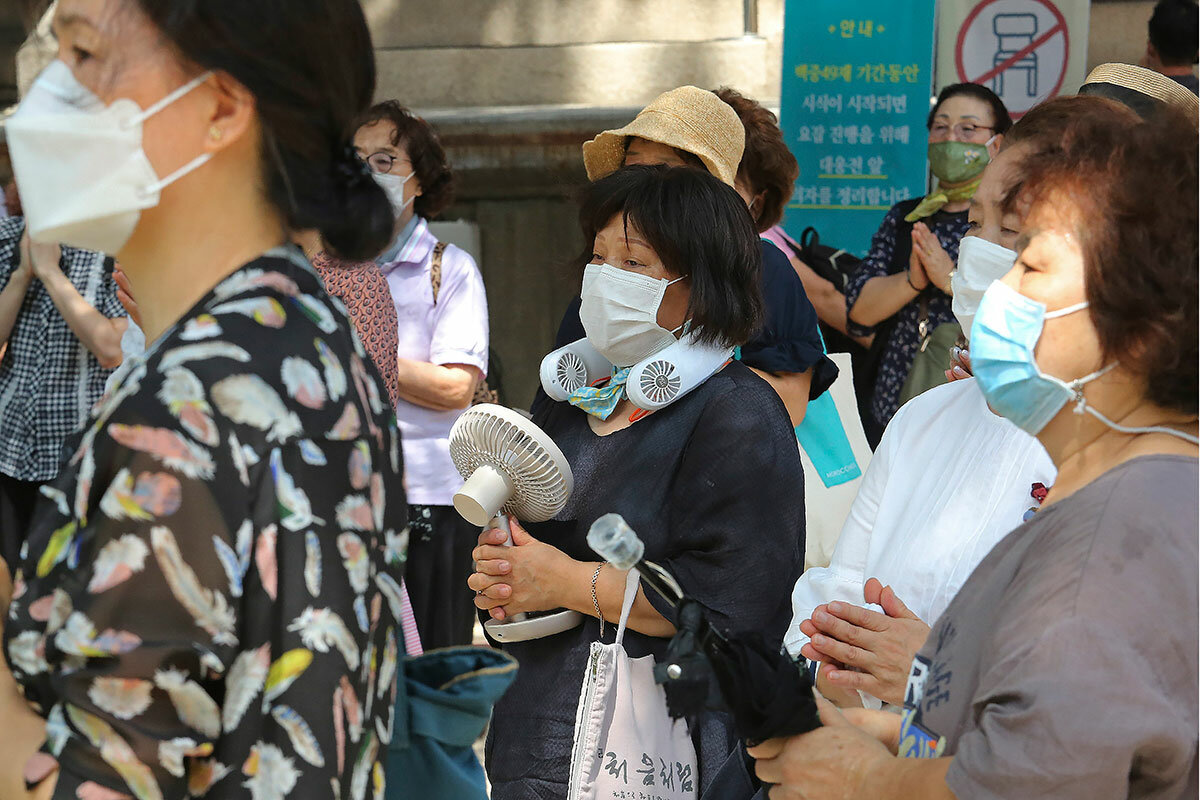Counting the climate cost of post-pandemic economy reboots
| London
Something extraordinary is happening in the worldwide fight against the coronavirus pandemic: Some governments have been telling people that it’s fine not to wear face masks.
That’s not because they’ve suddenly changed their minds about the value of masks in preventing new outbreaks. It’s a response to another global health and safety challenge: global warming.
Amid record-high temperatures in the United States, Europe, the Middle East, and Asia, officials in some countries have decided that the immediate risk of overheating must be weighed alongside the danger of catching COVID-19.
Why We Wrote This
Record-high temperatures around the world are reminding people what climate change feels like. Can governments summon the same urgency to controlling carbon emissions that they have brought to battling the COVID-19 pandemic?
The calculation underscores a deeper policy tension. That’s between the drive to get national economies restarted as soon as possible, and the hope among climate experts that world leaders’ efforts to tackle one great natural challenge – the pandemic – will lend new urgency to facing another one: reducing carbon emissions.
The signs of whether that will happen remain mixed, despite some high-profile new commitments, especially by European Union countries.
Yet the signs of climate change are getting stronger. Two new studies have charted the hugely accelerating loss of the world’s ice sheets.
The first revealed that in the far northern reaches of Canada, the country’s last intact ice shelf has fractured. A mass of ice nearly the size of Manhattan has collapsed into the Arctic Ocean. The second report, late last month, found that the Greenland ice sheet had lost a record amount of ice in the summer of 2019: more than twice the yearly average and enough to inundate the state of California under four feet of water.
Not all of this is due to global warming. Annual climate patterns play a role as well. But the trend since the turn of the century – rising carbon emissions, rising temperatures, and larger melts – is unmistakable. “Not only is the ice sheet melting,” said the lead author of the Greenland study. “It’s melting at a faster and faster pace.”
Neither of these climate reports received much international attention. That’s perhaps not surprising. News about climate change, like nearly everything else, has been crowded out by the pandemic.
But another sign of climate change has been impossible to ignore in the past few weeks: soaring temperatures in a number of countries around the globe.
In the U.S., Californians are facing the twin challenge of wildfires and searing heat, well over 100 degrees Fahrenheit. The state weather service has warned of “dangerous to potentially deadly” temperatures.
European countries including Britain and France have been hit by extreme temperatures over the summer, and the heat is now targeting southern and eastern areas of the continent.
But it’s been even more intense in the Middle East. Earlier in the summer, the Iraqi capital of Baghdad was hit by temperatures over 125 degrees Fahrenheit. In recent days, Israel has also experienced its hottest days on record, up to 120 degrees in the Red Sea resort of Eilat.
Israeli health authorities were among those easing their face mask guidance. They advised people who are distanced from others at a park or on a beach that they can remove their masks.
In Japan, where temperatures climbed last month to a record 106 degrees Fahrenheit, the national tourist organization was more explicit. Urging people to “remove your mask” when socially distanced outdoors, it warned that “wearing a mask … with high temperature and humidity may cause heat stroke.”
But climate scientists and activists want to see the pandemic spark longer-term adjustments. They point out that when COVID-19 first hit many countries, the resulting economic shutdowns, though unwelcome, did provide clear evidence of humankind’s impact on the environment and of the potential benefits of altering our behavior. Carbon emissions fell. The air became dramatically clearer.
The other pandemic lesson they hope politicians will take on board is that the effects of climate change – like COVID-19 – do not stop at national borders, and that this means they require a concerted international response. With governments spending unheard-of sums to rescue and resuscitate their countries’ economies, climate activists want more of that money to create and support low-carbon businesses.
A number of countries worldwide have announced cleaner-energy targets as part of their economic reconstruction plans. But the 27-nation European Union has led the way, with a nearly $900 billion recovery package, of which 30% is earmarked for less carbon-intensive energy generation.
The EU aims to become carbon-neutral by 2050, but that is a target it set for itself a year ago, and an alliance of thousands of climate scientists and policy advocates, including the teenage Swedish activist Greta Thunberg, has criticized the new EU plan as too cautious and vague.
The recovery plan receiving the warmest welcome from climate activists has, in fact, come from someone who does not hold office: U.S. Democratic Party presidential hopeful Joe Biden. He has announced a $2-trillion blueprint, pledging to ratchet up government support for electric vehicles, carbon-free power and energy efficiency – with a carbon-neutral target of 2045. Nearly half of the investment would go to minority and disadvantaged communities.
The hope of Ms. Thunberg and fellow campaigners is that the EU and other countries will add fresh detail and greater ambition to their plans as the economic recovery takes root. The key, they say, is that nations should summon the same sense of urgency – the sense of “emergency,” in Ms. Thunberg’s phrase – that they have brought to battling the pandemic.








